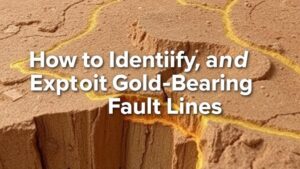How the Silver Placers of Animas Creek Were Discovered and Worked
The Discovery and Development of the Silver Placers of Animas Creek
The silver placers of Animas Creek, located in the picturesque San Juan Mountains of Colorado, represent a significant chapter in American mining history. Discovered in the mid-19th century, these placers were instrumental in the economic development of the region and attracted a wave of prospectors seeking fortune. This article delves into the discovery of these silver-rich deposits and the methods employed to extract the precious metal.
Historical Context and Discovery
The narrative of Animas Creeks silver placers begins against the backdrop of the 1849 California Gold Rush, which ignited a wave of exploration and mining throughout the western United States. By the mid-1850s, reports of silver discoveries began to surface, particularly in the mountainous regions of Colorado.
In 1860, a critical moment occurred when a group of prospectors, led by a man named A.A. Evans, began to explore the Animas River region. They discovered silver ore outcrops and soon focused their efforts on Animas Creek. According to local records, the first significant silver strike was made when these prospectors noticed the high concentration of silver-bearing minerals within the creek bed.
Initial Challenges and Early Mining Techniques
The natural topography of the Animas Creek area presented both opportunities and challenges for early miners. The steep, rugged terrain made access difficult, and the remote location posed logistical hurdles for transporting mining equipment and supplies. Still, prospectors employed several techniques to extract silver from the placers.
- Panning: This was the simplest method, involving a shallow pan to separate heavier silver particles from lighter materials in the creek water. Prospects were often made quickly, but this method yielded limited quantities.
- Long Tom: A more sophisticated version of panning that used a wooden trough to sluice water through sediments to capture heavier minerals, significantly increasing yield.
- Rockers: Rocking cradles were also introduced, which allowed operators to process larger amounts of material and was more efficient than hand panning.
Economic Impact and Growth of Mining Operations
The discovery of the silver placers at Animas Creek led to substantial economic activity in the region. As word spread about the silver findings, the population swelled with miners, merchants, and entrepreneurs. The need for supplies and services catalyzed the establishment of camps and small towns, such as Silverton.
By the late 1860s, large-scale mining operations began to emerge, employing hydraulic methods that allowed miners to extract silver from materials that were previously too difficult to reach. This transition to more industrial techniques signified a shift from individual prospectors to organized mining companies, dramatically increasing silver output in the area.
Environmental and Social Considerations
While the economic benefits of silver mining in Animas Creek were substantial, the environmental consequences were also significant. Early mining operations often led to water contamination and habitat destruction, leading to long-term ecological impacts. Plus, the influx of miners transformed local social dynamics, affecting Indigenous populations and creating new communities with diverse ethnic backgrounds.
Conclusion: Legacy of Animas Creek’s Silver Placers
The silver placers of Animas Creek played a pivotal role in the Colorado mining boom and illustrated the complex interplay of opportunity, innovation, and environmental consequences in the pursuit of wealth. Although large-scale mining eventually dwindled as richer deposits were exhausted, the legacy of Animas Creek persists in the mining heritage of the region, influencing local culture and economy into the present day.
Actionable Takeaways
- Understanding the history of mining can provide insights into current environmental issues and sustainable practices in resource extraction.
- Researching local mining history can enhance awareness of regional culture and the effects of industrial development.
- There are opportunities for recreation and education at historical mining sites, which can foster appreciation for the mining heritage.


